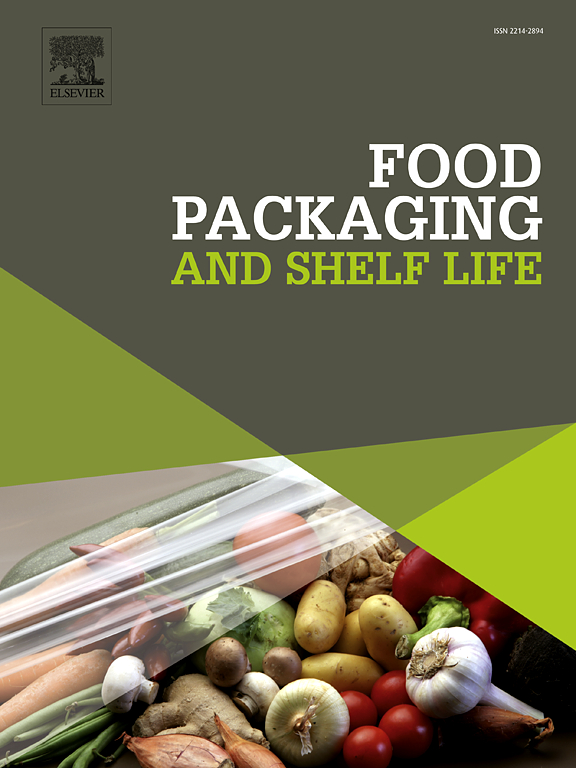碳量子点修饰二硫化钼的制备及其在超高氧障纳米复合包装薄膜中的应用
IF 8.5
1区 农林科学
Q1 FOOD SCIENCE & TECHNOLOGY
引用次数: 0
摘要
聚乙烯醇(PVA)是一种可生物降解的聚合物,在食品包装工业中引起了相当大的兴趣。然而,由于其固有的突出透光性、亲水性和水溶性,PVA薄膜作为食品包装材料的功效受到限制。新兴的二维材料,特别是过渡金属二硫族化合物,在增强聚合物基纳米复合材料的机械、热、光学、紫外线阻挡和氧阻隔性能方面表现出巨大的潜力。在本研究中,通过超声波混合和液体剥离合成了水分散的少层MoS2纳米片,并与掺银氮功能化碳量子点(Ag-NCQDs)集成,简称MoS2-Ag-NCQDs。在PVA基体中加入1 wt%的MoS2-Ag-NCQDs,结晶度、热稳定性和氧屏障性能都得到了显著改善。聚合物基体结晶度的提高通过增加扩散途径和降低渗透速率来限制气体分子的迁移率。值得注意的是,MoS2-Ag-NCQD纳米材料的掺入显著提高了氧屏障性能,与纯PVA膜相比,氧透过率降低了99.8 %。这一显著的改善归功于MoS2纳米片的结晶度增强、高长宽比和优异的剥落性,这有助于与气体分子有效相互作用并阻碍它们的运动。此外,PVA/MoS2-Ag-NCQDs纳米复合膜显著提高了生姜的保存性和营养完整性,从而延长了生姜的保质期。这项研究强调了MoS2-Ag-NCQD纳米材料在改善氧屏障性能,推进制药应用以及增强食品包装系统中紫外线屏蔽方面的潜力。本文章由计算机程序翻译,如有差异,请以英文原文为准。
Preparation of MoS2 modified with carbon quantum dots and its application to extremely high oxygen-barrier nanocomposite films for packaging
Polyvinyl alcohol (PVA), a biodegradable polymer, has attracted considerable interest in the food packaging industry. However, the efficacy of PVA films as food packaging materials is limited owing to their inherently highlight transmittance, hydrophilicity, and solubility in water. Emerging two-dimensional materials, particularly transition metal dichalcogenides, exhibit significant potential in enhancing the mechanical, thermal, optical, ultraviolet-blocking, and oxygen barrier properties of polymer-based nanocomposites. In this study, few-layered water-dispersible MoS2 nanosheets were synthesized via ultrasonic mixing and liquid exfoliation and integrated with Ag-doped nitrogen-functionalized carbon quantum dots (Ag-NCQDs), referred to as MoS2-Ag-NCQDs. Incorporating only 1 wt% of MoS2-Ag-NCQDs into a PVA matrix resulted in notable improvements in crystallinity, thermal stability, and oxygen barrier properties. The improved crystallinity of the polymer matrix constrained the gas molecule mobility by increasing diffusion pathways and lowering the permeation rates. Notably, the incorporation of MoS2-Ag-NCQD nanomaterials significantly enhanced the oxygen barrier performance, yielding a 99.8 % reduction in the oxygen transmission rate with that of pure PVA films. This remarkable improvement is attributed to the enhanced crystallinity, high aspect ratio, and superior exfoliation of the MoS2 nanosheets, which facilitate effective interactions with gas molecules and impede their movement. Furthermore, the PVA/MoS2-Ag-NCQDs nanocomposite films significantly improved ginger's preservation and nutritional integrity, thereby extending its shelf life. This study highlights the potential of MoS2-Ag-NCQD nanomaterials for improving oxygen barrier performance, advancing pharmaceutical applications, and enhancing ultraviolet shielding when used in food packaging systems.
求助全文
通过发布文献求助,成功后即可免费获取论文全文。
去求助
来源期刊

Food Packaging and Shelf Life
Agricultural and Biological Sciences-Food Science
CiteScore
14.00
自引率
8.80%
发文量
214
审稿时长
70 days
期刊介绍:
Food packaging is crucial for preserving food integrity throughout the distribution chain. It safeguards against contamination by physical, chemical, and biological agents, ensuring the safety and quality of processed foods. The evolution of novel food packaging, including modified atmosphere and active packaging, has extended shelf life, enhancing convenience for consumers. Shelf life, the duration a perishable item remains suitable for sale, use, or consumption, is intricately linked with food packaging, emphasizing its role in maintaining product quality and safety.
 求助内容:
求助内容: 应助结果提醒方式:
应助结果提醒方式:


